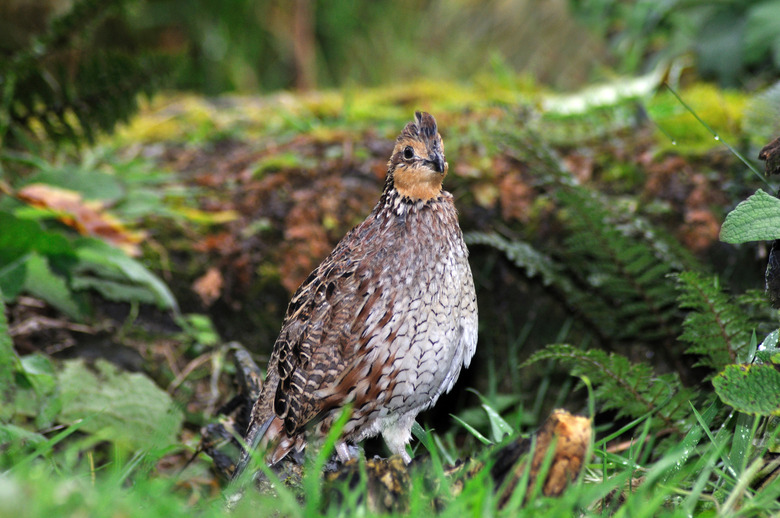The Difference Between Pharaoh Quail Vs. Bobwhite Quail
As a representative of the family of Old World quails, Phasianidae, the pharaoh quail (Coturnix japonica) – also known as the Japanese quail – is related to pheasants, turkeys, chickens and peafowl. The bobwhite quail (Colinus virginianus) on the other hand, belongs to the family Odontophoridae, or the New World quails. The latter family, true its name, inhabits North America and is only distantly related to the Old World species, which range throughout Europe, Asia and Africa.
The eggs of the pharaoh quail have been a dietary staple throughout its native habitat, particularly Japan, and the birds have been domesticated since the 13th century. Many chicken farmers in North America raise them, and by interbreeding, have produced larger sizes for meat. The Texas A&M quail size can top 14 ounces, which is more than a meal for an average person. The bobwhite also makes a tasty meal. Originally a game bird, it has been bred in captivity to yield several subspecies, including the Northern bobwhite, the Tennessee red bobwhite and the snowflake bobwhite.
Native Habitat of the Pharaoh Quail vs. the Bobwhite Quail
Native Habitat of the Pharaoh Quail vs. the Bobwhite Quail
Although both the pharaoh quail and the bobwhite quail have been domesticated throughout the world, their native habitats are on opposite sides of the globe. The pharaoh quail is a migratory species, spending summers in Russia, Japan, Korea and China, and summering in the southern parts of those countries as well as in parts of Africa and southeast Asia. Bobwhites, on the other hand, never stray far from their native habitat in the eastern United States from the southern tip of Lake Michigan to northern Mexico. They are well distributed throughout the region and can be found there year-round. They spend the winter huddled together in coveys that can number in the hundreds of birds.
Size, Appearance and Distinguishing Features
Size, Appearance and Distinguishing Features
The pharaoh quail is also known as the coturnix quail – sometimes misspelled cortnix quail – and there are many subspecies, each with a characteristic size and coloration. In the wild, an adult pharaoh quail weighs about 6 ounces. The male, which is slightly smaller than the female, has an overall brown coloration with some mottling and a rufous chest. The female looks almost the same but has a whitish chest. The pharaoh quail makes a characteristic sound consisting of deep, hollow sounds repeated several times in succession.
The bobwhite quail is about the same size as the pharaoh quail, and it's known by its distinguishing call, which sounds like its name. It has a speckled body, and the male sports a jet-black and white plumage on its head, giving it a distinctive appearance that could never be mistaken for a pharaoh quail. The female does not have the dramatic head plumage.
Domestication and Breeding
Domestication and Breeding
Both quail species are favorites of breeders who have created several subspecies. Interbreeding the coturnix quail has produced such species as the English white, which is pure white; the Texas A&M, which is also white; and the jumbo coturnix, which can weigh almost a pound. Bobwhite subspecies are more varied, numbering about 20 in all. They include snowflakes and Butlers, which can also weigh a pound.
Pharaoh quails have been bred for centuries and are docile in captivity. Bobwhites, on the other hand, have been bred for less than 100 years and can be quite aggressive in captivity. Breeders recommend keeping the birds in pairs, but not trios. When you add a third bird, there's often trouble, and one of them gets killed.
Cite This Article
MLA
Deziel, Chris. "The Difference Between Pharaoh Quail Vs. Bobwhite Quail" sciencing.com, https://www.sciencing.com/difference-quail-vs-bobwhite-quail-8443498/. 22 November 2019.
APA
Deziel, Chris. (2019, November 22). The Difference Between Pharaoh Quail Vs. Bobwhite Quail. sciencing.com. Retrieved from https://www.sciencing.com/difference-quail-vs-bobwhite-quail-8443498/
Chicago
Deziel, Chris. The Difference Between Pharaoh Quail Vs. Bobwhite Quail last modified March 24, 2022. https://www.sciencing.com/difference-quail-vs-bobwhite-quail-8443498/
